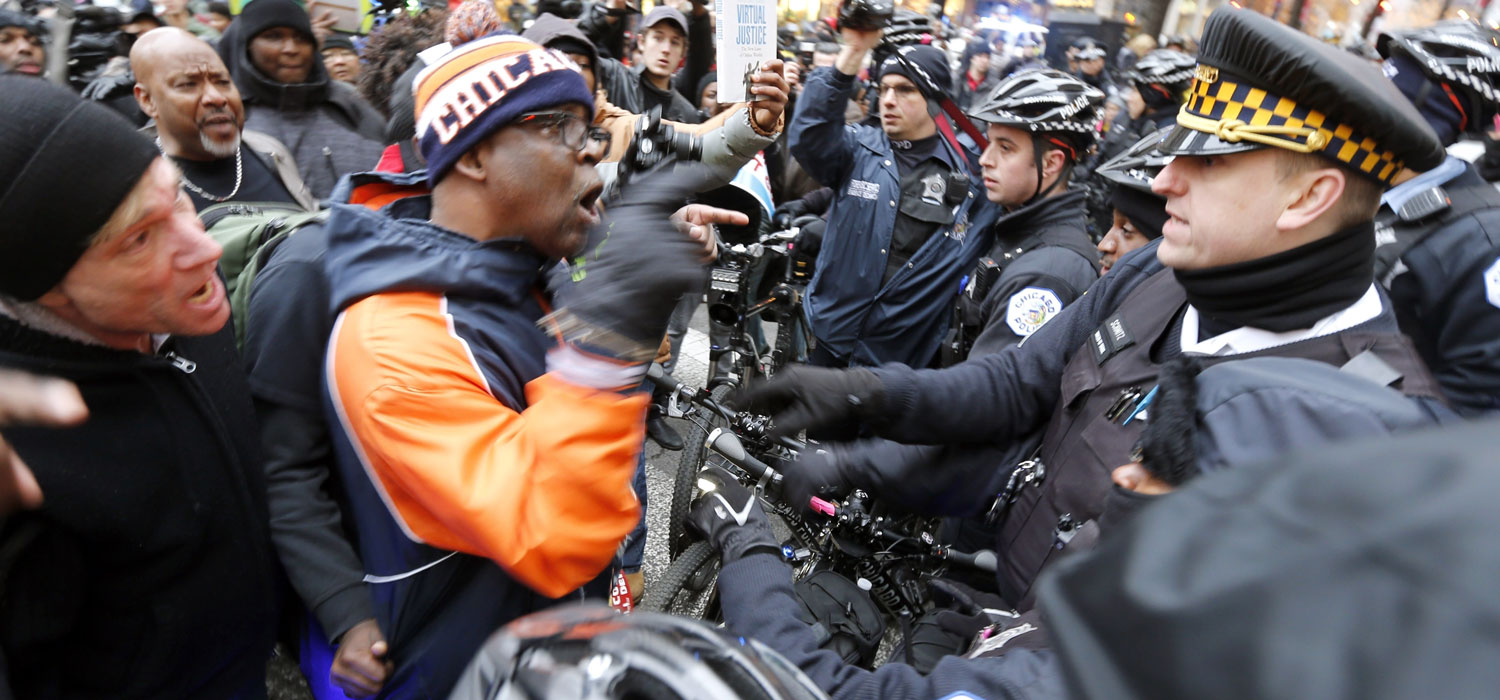
<p>In this Dec. 24, 2015 file photo, protesters yell at Chicago Police officers at a bicycle barricade in Chicago. A day after a task force blasted the Chicago Police Department for decades of discrimination Wednesday, April 13, 2016, city and law enforcement officials weighed which of the panel's recommendations could be adopted and how much they might cost. Photo by Charles Rex Arbogast/AP/File</p>
The White House's My Brother’s Keeper Initiative and the MBK Alliance call for public and private efforts to help boys and young men of color achieve milestones at the same rate as others in the United States. This blog series discusses strategies that could be effective in meeting those goals.
Last November, the Chicago Police Department (CPD) released a grainy, 90-second dashcam video showing a police officer fatally shooting 17-year-old Laquan McDonald. The clip produced a swift outcry that led to sustained, organized protests and months of handwringing by the mayor’s administration.
Five months later, the Chicago Police Accountability Task Force (itself a product of this outcry) released a report that dives into a national conversation about the treatment of people of color at the hands of the police.
Issues of criminal justice and racial equity—such as racial disparities in police interactions, sentencing, and incarceration—have received growing attention thanks to efforts like the Black Lives Matter movement and President Obama’s My Brother’s Keeper initiative. Simultaneously, many communities—especially communities of color in cities like Chicago—face daily violent crime that, while gradually declining, remains at epidemic levels, damaging residents in countless direct and indirect ways.
What the Chicago report found
The Chicago report, which comes after weeks of fact-finding and public comments, showed clear evidence of the CPD’s inequitable treatment of people of color. Three-quarters of shootings by police hit or killed African Americans, even though African Americans comprise only a third of the city’s population. African Americans were pulled over for traffic stops twice as frequently as whites and Latinos.
The report concluded that the CPD’s “own data gives validity to the widely held belief the police have no regard for the sanctity of life when it comes to people of color.”
Mayor Rahm Emanuel has not shied away from these claims, admitting that “there’s racism that exists in the city of Chicago and obviously could be in our department.” These explicit acknowledgments of the role race plays in policing are major steps forward.
Most people living in a diverse society inevitably display some level of subconscious, implicit bias involving race, which unintentionally plays off stigmas and associations beyond any individual’s control. But conscious, explicit racism still exists and shapes decisionmaking in institutions like the CPD. Acknowledging this is uncomfortable, but it presents an opportunity: there is something tangibly wrong that must be fixed.
Just as important is the link between explicit institutional racism in the justice system and a collapse in trust between citizens and officers, which ultimately impedes effective policing. People won’t help the police do their job if they fear they might be stopped on the way to the store, or arrested or assaulted if they ever need to call for help. Some Chicagoans told the task force they “felt like they didn’t even have a claim to the geography in front of their house.” Police must rebuild relationships with citizens so that both groups feel comfortable asking the other for help.
How police can rebuild community relationships
To build better community relationships, officers need training. A police force better prepared to identify mental health crises and deescalate incidents could prevent tragedies like the deaths last December of Quintonio LeGrier and Bettie Jones at the hands of Chicago police. And a justice system aimed at rehabilitation and restorative justice would halt the needless destruction of lives and families that results when those convicted of crimes are incarcerated.
Another helpful change would be to better align police and community priorities. People of color want to see fewer shootings and less low-level crime in their neighborhoods, but one is certainly more urgent than the other. So when police turn a disparate amount of attention to, for example, traffic stops, they appear out of touch and even counterproductive. By placing greater emphasis on community feedback when shaping enforcement priorities, police give residents the sense that their input and engagement makes a difference.
Police must also create structures to hold themselves accountable, like a civilian oversight board, as the Chicago report calls for. Without an institutional focus on reprimanding misconduct and weeding out repeat offenders, police might not pay attention to their rules of conduct.
Data collection initiatives, like that led by the Center for Policing Equity as part of My Brother’s Keeper, will be pivotal to identifying patterns of misconduct and departments in need of reform. In particular, Chicago police must eliminate the “code of silence” that discourages whistleblowing. And police forces should also take note of evidence—incomplete but growing—that body cameras lower the risk of misconduct.
An adversarial relationship between police and communities of color is a route to mutually assured destruction. In communities that face numerous disadvantages, it is all too easy to lower our expectations for public services. But cities like Chicago can do better. They must empower their police forces to reboot relationships with their neighborhoods.
As the report reads, the CPD “cannot begin to build trust, repair what is broken and tattered unless… it faces these hard truths, acknowledges what it has done at the individual and institutional levels, and earnestly reaches out with respect.”
Let’s build a future where everyone, everywhere has the opportunity and power to thrive
Urban is more determined than ever to partner with changemakers to unlock opportunities that give people across the country a fair shot at reaching their fullest potential. Invest in Urban to power this type of work.